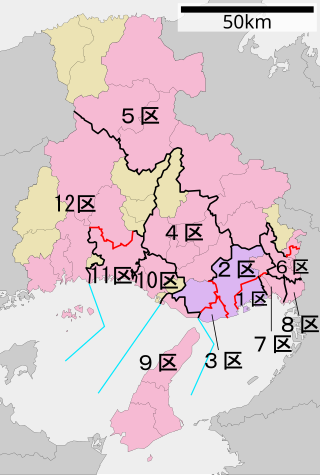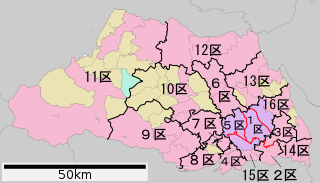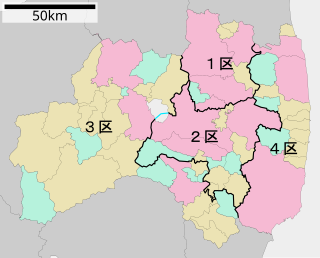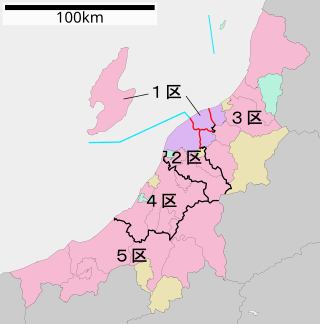Related Research Articles
Gunma 3rd district was a constituency of the House of Representatives in the Diet of Japan. Between 1947 and 1993 it elected four representatives by single non-transferable vote. As of 1993, it comprised the cities of Takasaki, Shibukawa, Fujioka, Tomioka, Annaka and the Gunma, Kitagunma, Tano, Kanra, Usui and Agatsuma districts.

Gunma At-Large District is a constituency of the House of Councillors in the Diet of Japan. It consists of Gunma Prefecture and elects two Councillors, one per election.

Chiba 4th district is a constituency of the House of Representatives in the Diet of Japan. It is located in the city of Funabashi in Western Chiba. As of 2016, 459,431 eligible voters were registered in the district. In the 2009 and 2012 general elections, the district had the lowest electoral weight throughout Japan at more than two times as many voters as the district with the highest electoral weight, Kōchi-3rd.
Nagasaki 1st district was a constituency of the House of Representatives in the Diet of Japan. Between 1947 and 1993 it elected five Representatives by single non-transferable vote. It was located in Nagasaki and, as of 1993, consisted of the cities of Nagasaki, Isahaya and Shimabara and the Nishisonogi, Kitatakaki, Minamitakaki, Kamiagata and Shimoagata counties.

Hyogo 11th district is a constituency of the House of Representatives in the Diet of Japan. It is located in Southwestern Hyōgo and is based on the 1995 borders of the city of Himeji; the former towns of Ieshima, Yumesaki, Kōdera and Yasutomi that merged into Himeji in 2006 are part of the 12th district. As of September 2015, 387,509 eligible voters were registered in the district.

Saitama 3rd district is a constituency of the House of Representatives in the Diet of Japan. It is located in Southeastern Saitama and consists of the cities of Kawaguchi and Koshigaya. As of 2012, 460,884 eligible voters were registered in the district.

Ibaraki 4th district is a single-member constituency of the House of Representatives in the Diet of Japan. It is located in Northern Ibaraki and consists of the cities of Hitachinaka, Hitachiōta, Hitachiōmiya and Naka and the town of Daigo. As of 2021, 268,147 eligible voters were registered in the district.

Gunma 4th district is a single-member constituency of the House of Representatives in the Diet of Japan. It is located in Southern Gunma and consists of the city of Fujioka, the Southern part of Takasaki city as well as Kanna town and Ueno village in Tano county. As of 2009, 292,356 eligible voters were registered in the district.

Fukushima 3rd district is a single-member constituency of the House of Representatives in the Diet of Japan, located in Western Fukushima Prefecture. The electoral district lies mostly in the Aizu region and consists of the cities of Aizuwakamatsu, Shirakawa and Kitakata and six districts: Minamiaizu, Higashishirakawa, Yama, Kawanuma, Ōnuma and Nishishirakawa. As of 2012, 293,378 eligible voters were registered in the district.
Kyōto 2nd district was a multi-member constituency of the House of Representatives in the Diet of Japan. Between 1947 and 1993 it elected five Representatives by single non-transferable vote. It was located in Kyōto and, as of 1993, consisted of Kyōto city's Ukyō, Fushimi and Nishikyō wards and all other cities, towns and villages in the prefecture.

Fukuoka 8th district is a single-member constituency of the House of Representatives in the Diet of Japan. It covers Northern central parts of Fukuoka including the city of Iizuka, home to the Asō family and Tarō Asō, Liberal Democratic Party (LDP) faction leader and the only representative for the 8th district since its creation. He was elected LDP president in 2008 against Kaoru Yosano and three other candidates, but resigned one year later following the most devastating general election result in party history – his successor would be the second LDP president in history not to become prime minister after his election. Yet, Asō carried his own district by an overwhelming margin in 2009.

Yamagata 1st district is a single-member constituency of the House of Representatives in the Diet of Japan. It is located in Eastern Yamagata and covers the cities of Yamagata, Kaminoyama and Tendō and the county of Higashimurayama. As of 2012, 306,446 eligible voters were registered in the district.
Kyōto 1st district was a constituency of the House of Representatives in the Diet of Japan. Between 1947 and 1993 it elected five Representatives by single non-transferable vote. It was located in Kyōto and consisted, as of 1993, of the cities of Kyōto city's wards of Sakyō, Higashiyama, Kamigyō, Kita, Nakagyō, Shimogyō, Minami and Yamashina. Today, the area is split between Kyōto 1st and 2nd single-member electoral districts.

Aomori 1st district is a single-member constituency of the House of Representatives in the national Diet of Japan. It is located in Northern Aomori and covers the cities of Aomori, Mutsu and the Higashitsugaru and Shimokita districts along with the northern half of the Kamikita District.

Hokkaidō 1st district is a single-member constituency of the House of Representatives, the lower house of the national Diet of Japan. It is located in Sapporo, the prefectural capital of Hokkaido. In 2017, its border were redrawn and it now consists of Sapporo's Chūō ("Centre") and Minami ("South") wards, a portion of Nishi ("West") ward as well as a small part of Kita ("North") ward.

Ishikawa 2nd district is a single-member constituency of the House of Representatives, the lower house of the national Diet of Japan. It is located in Southern Ishikawa Prefecture and covers the cities of Komatsu, Kaga, Nomi, Hakusan, Nonoichi and the town of Kawakita.

Kanagawa 10th district is a single-member electoral district for the House of Representatives, the lower house of the National Diet of Japan. It is located in North-eastern Kanagawa Prefecture and consists of Kawasaki City's three eastern wards of Kawasaki, Saiwai and Nakahara. As of September 2011, 494,755 voters were registered in the district, giving its voters the second lowest vote weight in the country behind Chiba 4th district.

Niigata 5th district is a single-member electoral district for the House of Representatives, the lower house of the National Diet of Japan. It is located in the central, Chūetsu region of Niigata and covers parts of Nagaoka City, the cities of Ojiya, Uonuma, Minami-Uonuma as well as the former Minami-Uonuma County that, as of 2012, only has one remaining municipality: Yuzawa Town. As of September 2012, 282,904 voters were registered in Niigata 5th district, giving its voters above average vote weight.

Yamaguchi 4th district is a single-member electoral district for the House of Representatives, the lower house of the National Diet of Japan. It is located in Western Yamaguchi and consists of the cities of Shimonoseki and Nagato. The seat was held by former Prime Minister of Japan Shinzo Abe until his assassination in July 2022. As of September 2011, 266,456 voters were registered in the district, giving its voters well above average vote weight. Unlike many prefectures where the capital is also the most populous city, Yamaguchi's major city is Shimonoseki, located at the western tip of Honshū and adjacent to Kyushu island's Fukuoka-Kitakyūshū metropolitan area which lies just south across the Kanmon Straits.
Nagasaki 3rd district is a single-member electoral district for the House of Representatives, the lower house of the National Diet of Japan. It is located in the prefecture of Nagasaki. It covers parts of Nagasaki on the main island of Kyūshū – the city of Ōmura and the towns of Kawatana, Hasami and Higashisonogi, Nagasaki in former Higashi-Sonogi-gun – and several of the prefecture's island municipalities: the cities of Iki, Tsushima and Gotō and the town of Shin-Kamigotō in Minami-Matsuura/"South Matsuura" district. As of September 2011, 211,289 eligible voters were registered in Nagasaki 3rd district, giving it the second highest vote weight in the country.
References
- ↑ 衆議院>第23回衆議院議員選挙>千葉県>千葉1区. ザ・選挙 (in Japanese). K.K. Heartbeats. Archived from the original on 2016-03-04. Retrieved 2011-08-16.
- ↑ 衆議院>第24回衆議院議員選挙>千葉県>千葉1区. ザ・選挙 (in Japanese). K.K. Heartbeats. Archived from the original on 2016-03-04. Retrieved 2011-08-16.
- ↑ 衆議院>第25回衆議院議員選挙>千葉県>千葉1区. ザ・選挙 (in Japanese). K.K. Heartbeats. Archived from the original on 2016-03-04. Retrieved 2011-08-16.
- ↑ 衆議院>第26回衆議院議員選挙>千葉県>千葉1区. ザ・選挙 (in Japanese). K.K. Heartbeats. Archived from the original on 2016-03-03. Retrieved 2011-08-16.
- ↑ 衆議院>第27回衆議院議員選挙>千葉県>千葉1区. ザ・選挙 (in Japanese). K.K. Heartbeats. Archived from the original on 2016-03-04. Retrieved 2011-08-16.
- ↑ 衆議院>第28回衆議院議員選挙>千葉県>千葉1区. ザ・選挙 (in Japanese). K.K. Heartbeats. Archived from the original on 2016-03-04. Retrieved 2011-08-16.
- ↑ 衆議院>第29回衆議院議員選挙>千葉県>千葉1区. ザ・選挙 (in Japanese). K.K. Heartbeats. Archived from the original on 2016-03-04. Retrieved 2011-08-16.
- ↑ 衆議院>第30回衆議院議員選挙>千葉県>千葉1区. ザ・選挙 (in Japanese). K.K. Heartbeats. Retrieved 2011-08-16.[ permanent dead link ]
- ↑ 衆議院>第31回衆議院議員選挙>千葉県>千葉1区. ザ・選挙 (in Japanese). K.K. Heartbeats. Archived from the original on 2016-03-04. Retrieved 2011-08-16.
- ↑ 衆議院>第32回衆議院議員選挙>千葉県>千葉1区. ザ・選挙 (in Japanese). K.K. Heartbeats. Archived from the original on 2016-03-03. Retrieved 2011-08-16.
- ↑ 衆議院>第33回衆議院議員選挙>千葉県>千葉1区. ザ・選挙 (in Japanese). K.K. Heartbeats. Archived from the original on 2016-03-04. Retrieved 2011-08-16.
- ↑ 衆議院>第34回衆議院議員選挙>千葉県>千葉1区. ザ・選挙 (in Japanese). K.K. Heartbeats. Archived from the original on 2016-03-04. Retrieved 2011-08-16.
- ↑ 衆議院>第35回衆議院議員選挙>千葉県>千葉1区. ザ・選挙 (in Japanese). K.K. Heartbeats. Archived from the original on 2016-03-04. Retrieved 2011-08-16.
- ↑ 衆議院>第36回衆議院議員選挙>千葉県>千葉1区. ザ・選挙 (in Japanese). K.K. Heartbeats. Archived from the original on 2016-03-04. Retrieved 2011-08-16.
- ↑ 衆議院>第37回衆議院議員選挙>千葉県>千葉1区. ザ・選挙 (in Japanese). K.K. Heartbeats. Archived from the original on 2016-03-04. Retrieved 2011-08-16.
- 1 2 衆議院>第38回衆議院議員選挙>千葉県>千葉1区. ザ・選挙 (in Japanese). K.K. Heartbeats. Archived from the original on 2016-03-04. Retrieved 2011-08-16.
- 1 2 衆議院>第39回衆議院議員選挙>千葉県>千葉1区. ザ・選挙 (in Japanese). K.K. Heartbeats. Archived from the original on 2016-03-04. Retrieved 2011-08-16.
- 1 2 衆議院>第40回衆議院議員選挙>千葉県>千葉1区. 選挙ドットコム (senkyo dot com) (in Japanese). イチニ株式会社 (Ichini K.K.). Retrieved 2021-05-17.